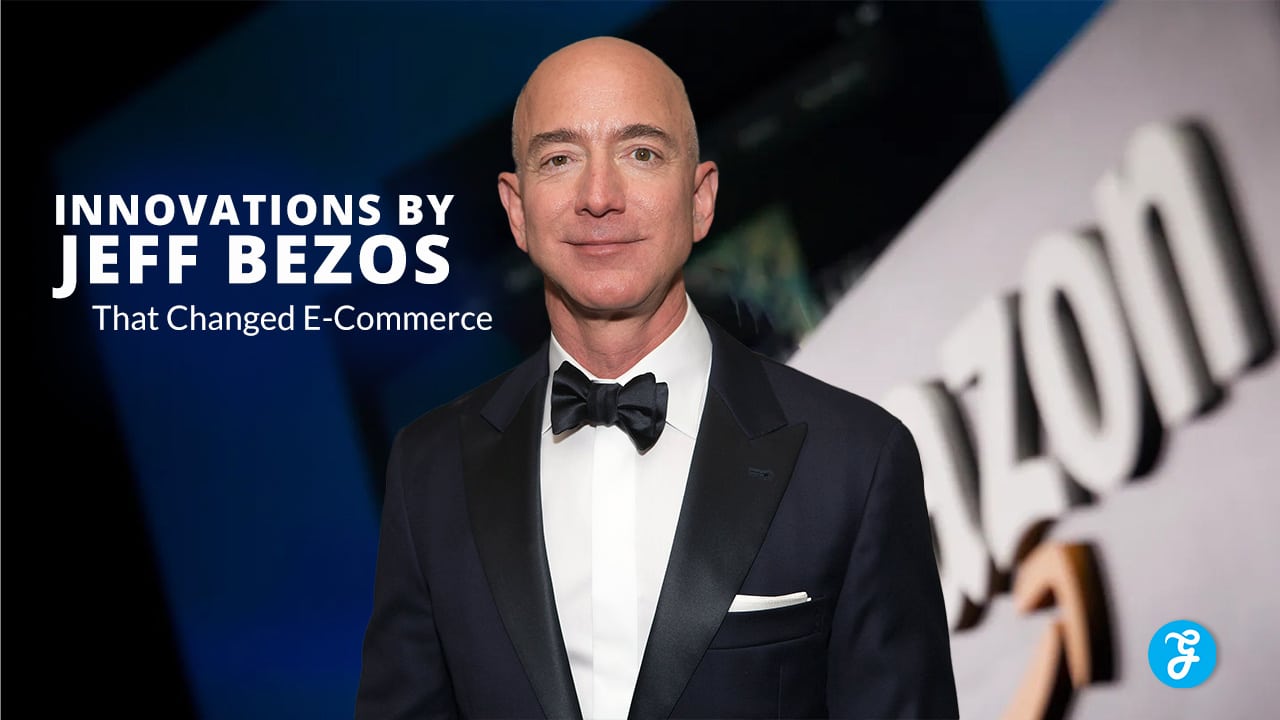Jeff Bezos, the founder of Amazon, has been a driving force in the world of e-commerce for over two decades. His innovative ideas and relentless focus on customer satisfaction have transformed not just how we shop online, but also how businesses operate in the digital age. This article explores 20 key innovations introduced by Bezos that have reshaped the e-commerce landscape.
In this article, we’ll dive deep into 20 of Jeff Bezos’ most impactful innovations. We’ll explore how each one has transformed e-commerce, and why they matter not just to shoppers, but to the entire business world. So, buckle up and get ready for a journey through the mind of one of the most influential entrepreneurs of our time.
1. The Online Bookstore: Where It All Began
In 1994, when most people were still getting used to dial-up internet, Jeff Bezos had a revolutionary idea: what if you could buy books online? It sounds simple now, but back then, it was groundbreaking.
Bezos chose books for a reason. They were easy to ship, had a long shelf life, and there was a huge variety – far more than any physical bookstore could stock. Plus, with books, Bezos could build a database of millions of items, laying the groundwork for what would become the “everything store.”
The online bookstore solved a real problem for readers. No more driving to multiple stores to find that obscure title. No more limited selections based on what fit on the shelves. With Amazon, readers could access millions of titles from the comfort of their homes.
But Bezos didn’t stop at just listing books. He added features like editorial and customer reviews, turning Amazon into not just a store, but a community for book lovers. This was the first step in Bezos’ strategy of making shopping online not just convenient, but engaging and informative.
2. Customer Reviews: The Power of Social Proof
In 1995, Amazon introduced customer reviews, a feature that would become a cornerstone of online shopping. This wasn’t just a minor addition – it was a fundamental shift in how people made purchasing decisions.
Before Amazon, shoppers relied on professional critics, salespeople, or word-of-mouth from friends and family. With customer reviews, suddenly every shopper had access to opinions from hundreds or even thousands of other buyers.
This innovation did more than just help shoppers make informed decisions. It created a sense of community and trust around Amazon. Shoppers weren’t just buying from a faceless corporation; they were part of a community of fellow consumers sharing their experiences.
The impact of this innovation extended far beyond Amazon. Today, customer reviews are a standard feature across e-commerce platforms, influencing everything from product development to marketing strategies.
3. One-Click Ordering: Simplifying the Purchase Process
In 1999, Amazon patented its one-click ordering system, a seemingly simple innovation that had a massive impact on e-commerce. The concept was straightforward: allow customers to make purchases with a single click, using pre-stored shipping and payment information.
This innovation addressed a significant problem in online shopping: cart abandonment. Many potential customers would add items to their cart but leave without completing the purchase, often because the checkout process was too long or complicated.
One-click ordering eliminated these barriers. It made impulse purchases easier, increased conversion rates, and significantly improved the user experience. The impact was so significant that Apple later licensed the technology from Amazon for use in its iTunes store.
This innovation showcased Bezos’ obsession with reducing friction in the shopping process. By making buying as easy as possible, Amazon not only increased sales but also set a new standard for convenience in online shopping.
4. Personalized Recommendations: The Art of “You Might Also Like”
In 1998, Amazon introduced its recommendation system, a feature that would become one of the most powerful tools in e-commerce. Using complex algorithms, Amazon began suggesting products based on a customer’s browsing and purchase history.
This wasn’t just about increasing sales (although it certainly did that). It was about creating a personalized shopping experience for each customer. In a world where online stores could offer virtually unlimited inventory, personalized recommendations helped customers navigate this vast selection.
The recommendation system turned shopping into a discovery process. Customers weren’t just finding what they were looking for; they were discovering new products they didn’t even know they wanted. This kept customers engaged and coming back to see what Amazon would recommend next.
The impact of this innovation extended far beyond e-commerce. Today, recommendation systems are used across various industries, from streaming services suggesting what to watch next, to news sites recommending articles.
5. Amazon Prime: Redefining Customer Loyalty
Launched in 2005, Amazon Prime was more than just a shipping service – it was a complete reimagining of customer loyalty programs. For an annual fee, customers got free two-day shipping on eligible purchases.
This solved a major pain point in online shopping: shipping costs and delivery times. With Prime, customers could order as often as they liked without worrying about shipping fees, and they knew their items would arrive quickly.
But Prime was about more than just fast, free shipping. It changed customer behavior. Prime members, on average, spend significantly more on Amazon than non-members. They also tend to check Amazon first when shopping online, even for categories Amazon wasn’t traditionally known for.
Over time, Amazon has continually added benefits to Prime, including streaming video, music, and exclusive deals. This has turned Prime into not just a loyalty program, but a lifestyle service that keeps customers deeply integrated into the Amazon ecosystem.
6. Amazon Marketplace: Creating a Platform for Sellers
In 2000, Amazon opened its platform to third-party sellers, a move that would dramatically expand its product selection and cement its position as the “everything store.”
This wasn’t just about increasing inventory. By allowing other sellers on its platform, Amazon turned potential competitors into partners. It also meant Amazon could offer products in categories it didn’t specialize in, without having to manage that inventory itself.
For sellers, Marketplace offered access to Amazon’s vast customer base and trusted brand. For customers, it meant an even wider selection of products, often at competitive prices.
This model has become so successful that today, third-party sellers account for more than half of Amazon’s retail sales. It’s also inspired other retailers to create similar marketplaces, changing the dynamics of online retail.
7. Fulfillment by Amazon (FBA): Revolutionizing Logistics
Introduced in 2006, Fulfillment by Amazon (FBA) allowed third-party sellers to use Amazon’s vast logistics network. Sellers could send their products to Amazon’s warehouses, and Amazon would handle storage, packing, and shipping.
This innovation solved a major challenge for small and medium-sized businesses: logistics. With FBA, even small sellers could offer Amazon Prime shipping speeds and reliability.
For Amazon, FBA meant more control over the customer experience, even for third-party sales. It also allowed Amazon to more efficiently use its warehouse space and delivery networks.
FBA has had a profound impact on e-commerce. It’s enabled countless small businesses to reach a global market, and it’s raised customer expectations for fast, reliable shipping across the industry.
8. Amazon Web Services (AWS): The Unseen Giant
When Amazon launched AWS in 2006, few could have predicted its impact. What started as a way for Amazon to monetize its excess server capacity has grown into the world’s largest cloud computing platform.
AWS provides businesses with on-demand access to computing power, storage, and a wide range of other services. This has dramatically lowered the barriers to entry for tech startups and enabled large enterprises to become more agile.
For e-commerce, AWS has been transformative. It’s allowed businesses of all sizes to build and scale online stores without massive upfront investments in IT infrastructure. Many of Amazon’s competitors in e-commerce actually run their operations on AWS.
Today, AWS is Amazon’s most profitable division, and it’s changed the way businesses think about IT infrastructure. It’s a prime example of how Bezos’ innovations have impacted not just e-commerce, but the broader business world.
9. Kindle E-reader: Disrupting the Book Industry
When Amazon introduced the Kindle in 2007, it wasn’t just launching a new device – it was reimagining the entire book industry. The Kindle made e-books mainstream, offering a reading experience that in many ways surpassed physical books.
For readers, the Kindle offered convenience: thousands of books in a single device, instant delivery of new titles, adjustable text size, and more. For publishers and authors, it opened up new possibilities in publishing and distribution.
But the Kindle wasn’t just about hardware. Amazon created an entire ecosystem around e-books, from the Kindle Store for purchasing books to tools for self-publishing. This gave Amazon unprecedented influence over the book industry.
The Kindle’s impact extended beyond books. It paved the way for digital content consumption across various media, influencing everything from how we read newspapers to how we consume academic literature.
10. Amazon Prime Video: Entering the Streaming Wars
Launched in 2006 as Amazon Unbox and later rebranded as Prime Video, this service marked Amazon’s entry into the world of digital streaming. It was a natural extension of Amazon’s digital strategy and another way to add value to Prime memberships.
Prime Video isn’t just about providing content; it’s about keeping customers within the Amazon ecosystem. By offering original content alongside licensed titles, Amazon has positioned itself as a major player in the entertainment industry.
This move into streaming showcases Bezos’ strategy of continually adding services to make Prime more valuable. It also demonstrates Amazon’s willingness to compete in new industries, even those far removed from its original focus on e-commerce.
11. Amazon Echo and Alexa: The Voice-Activated Future
Introduced in 2014, the Amazon Echo with Alexa voice assistant brought the concept of ambient computing into homes. This wasn’t just a new gadget; it was a new way of interacting with technology and, by extension, with Amazon’s services.
For e-commerce, Alexa opened up possibilities for voice shopping. Customers could add items to their shopping lists or make purchases simply by speaking. This reduced friction in the shopping process even further, making it easier than ever to buy from Amazon.
But Echo and Alexa’s impact goes beyond shopping. They’ve become central hubs for smart home control, answering questions, playing music, and more. This has allowed Amazon to gather even more data about customer preferences and behaviors, further enhancing its ability to personalize experiences.
12. Amazon Go: Reimagining Physical Retail
Opened to the public in 2018, Amazon Go stores use advanced technology to eliminate checkout lines. Customers simply walk in, take what they want, and walk out, with charges automatically applied to their Amazon account.
This innovation showcases Bezos’ willingness to reimagine even the most fundamental aspects of retail. By eliminating what many consider the worst part of shopping – waiting in line – Amazon Go sets a new standard for convenience in physical retail.
Amazon Go also demonstrates how online and offline retail can be integrated. The technology behind these stores relies heavily on the kind of machine learning and computer vision techniques that Amazon has developed for its online operations.
13. Amazon Prime Air: The Promise of Drone Delivery
Announced in 2013, Amazon Prime Air aims to deliver packages by drone in 30 minutes or less. While still in development, this initiative shows Bezos’ commitment to pushing the boundaries of what’s possible in delivery logistics.
The potential impact of drone delivery is significant. It could dramatically reduce delivery times and costs, especially for last-mile delivery in urban areas. It also has the potential to make delivery services available in hard-to-reach areas.
While regulatory and technological challenges remain, Prime Air represents Bezos’ vision of a future where instant gratification in online shopping is not just an ideal, but a reality.
14. Amazon Flex: The Gig Economy Meets Delivery
Launched in 2015, Amazon Flex allows individuals to sign up as delivery drivers using their own vehicles. This program has helped Amazon increase its delivery capacity, especially during peak periods.
Flex represents Amazon’s adaptation to the gig economy model. It provides flexibility for workers and helps Amazon manage the fluctuating demand for delivery services.
This innovation has implications beyond just delivery. It’s part of a broader trend of companies using technology to create flexible workforces, changing traditional employment models.
15. Amazon Lockers: Solving the Last-Mile Problem
Introduced in 2011, Amazon Lockers are secure, self-service kiosks where customers can pick up or return Amazon packages. This innovation addresses several challenges in e-commerce delivery: package theft, missed deliveries, and the cost of last-mile delivery.
For customers, Lockers offer convenience and flexibility. For Amazon, they reduce delivery costs and provide another touchpoint with customers. Lockers have become particularly popular in urban areas and on college campuses.
This innovation shows Bezos’ holistic approach to improving the shopping experience, addressing pain points not just in ordering, but in receiving purchases as well.
16. AmazonFresh: Tackling the Grocery Market
Launched in 2007, AmazonFresh is a grocery delivery service that has expanded Amazon’s reach into the fresh food market. This move showed Bezos’ ambition to compete in every retail category, even those traditionally dominated by brick-and-mortar stores.
AmazonFresh leverages Amazon’s logistics expertise to solve the challenges of delivering perishable goods. It’s part of Amazon’s broader strategy to become a one-stop shop for all consumer needs.
The service has forced traditional grocery retailers to improve their own delivery options, accelerating the overall trend towards online grocery shopping.
17. Amazon Business: Entering the B2B Market
Launched in 2015, Amazon Business is a B2B marketplace that caters to the unique needs of businesses, from small offices to large institutions. This platform applies Amazon’s consumer e-commerce innovations to the world of business purchasing.
Amazon Business offers features like multi-user accounts, approval workflows, and integration with procurement systems. It’s an example of how Bezos has taken Amazon’s core competencies and applied them to new markets.
This move into B2B e-commerce has disrupted traditional business supply chains and forced other B2B suppliers to improve their online offerings.
18. Amazon Handmade: Supporting Artisans in the Digital Age
Introduced in 2015, Amazon Handmade allows artisans to sell their handcrafted goods to Amazon’s vast customer base. This platform competes with sites like Etsy, bringing the world of handcrafted goods to Amazon’s mainstream audience.
Handmade represents Bezos’ strategy of catering to niche markets within Amazon’s broader ecosystem. It allows Amazon to tap into the growing consumer interest in unique, handcrafted items.
For artisans, Handmade offers access to Amazon’s powerful marketing and logistics tools. For customers, it provides a way to support small businesses and individual craftspeople while enjoying the convenience of shopping on Amazon.
19. Amazon Studios: From Retailer to Content Creator
Founded in 2010, Amazon Studios marks Amazon’s foray into original content creation. This move transformed Amazon from a content distributor to a content producer, competing directly with traditional media companies.
Amazon Studios produces both movies and television series, many of which are exclusively available on Prime Video. This original content serves as another incentive for Prime membership and keeps customers engaged with Amazon’s ecosystem.
This innovation demonstrates Bezos’ willingness to vertically integrate, controlling more aspects of the value chain. It’s also an example of how Amazon leverages data from one part of its business (customer viewing habits) to inform another (content creation).
20. Whole Foods Acquisition: Bridging Online and Offline Retail
Amazon’s $13.7 billion acquisition of Whole Foods Market in 2017 was a seismic event in the retail world. It marked Amazon’s biggest push into brick-and-mortar retail and signaled its serious intentions in the grocery market.
This move allowed Amazon to leverage Whole Foods’ physical locations for order pickup and returns, bridging the gap between online and offline shopping. It also provided Amazon with valuable data on grocery shopping habits and a new platform for integrating its technology into physical stores.
The acquisition sent shockwaves through the grocery industry, prompting other retailers to accelerate their own digital transformation efforts. It’s a prime example of how Bezos’ innovations have impacts far beyond Amazon itself.
Takeaways
Jeff Bezos’ innovations have fundamentally changed how we shop, how businesses operate, and what customers expect from online retailers. From the humble beginnings of an online bookstore to a global e-commerce and technology giant, Bezos’ vision and relentless focus on innovation have set new standards for the industry. As e-commerce continues to evolve, the foundations laid by these 20 innovations will undoubtedly influence its future direction.






































